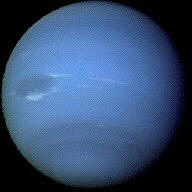
Neptune

Usually Neptune is the eighth planet from the Sun, but is occasionally further away from the Sun than Pluto, which is in a highly elliptical orbit. Neptune is the smallest of the four gas giants, just smaller than Uranus, but much more massive. Faint dark rings have been detected around the blue planet, but are much less substantial than those of Saturn or Uranus. The planet has two main moons: Triton with a diameter of 2,720 km, and Nereid only a few hundred km across, and in a highly elliptical orbit. Triton is a very dense moon and very cold, with a surface temperature of -236 degC. Its surface is shrouded in nitrogen and methane ice, and has a polar cap covered with pink snow. Six more moons were discovered to lie close to the planet within its rings, by Voyager 2.
Composition Despite being so far away from the Sun, Neptune has considerable internal heating due to its mass. This provides enough energy to drive 1,100km/h winds in the planet&rsquos atmosphere, which is mainly composed of hydrogen (85%), helium (13%) and methane which is visible as white cirrus like clouds high up in the atmosphere. Other features can be seen such as a large dark spot rotating in the southern hemisphere. This feature is similar in nature to the Great Red Spot on Jupiter. Like Uranus, Neptune has a magnetic field inclined to the rotational axis by a surprising amount, in this case 50 deg, and also offset from the planet's centre by some 10,000 km.
Probes to Neptune The only spacecraft to visit Neptune so far has been Voyager 2 in 1989, when it made its last encounter with a planet in our solar system. Despite a journey lasting 12 years, Voyager returned data and high resolution colour images of excellent quality, revealing Neptune and its moons as magnificent sights at the boundary of our place in the Galaxy.